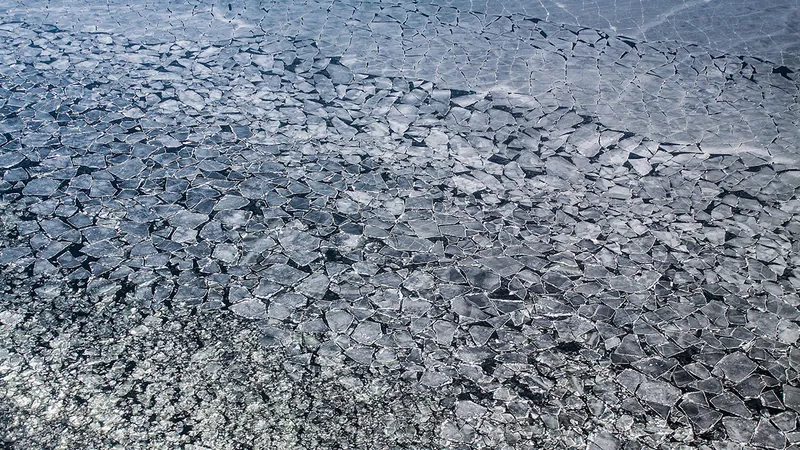
Surprising Discovery: Warm Sea Ice Transports Heat More Efficiently Than Previously Believed!
2024-10-01
Scientists have unveiled a groundbreaking discovery regarding sea ice: it can transport heat between the ocean and the atmosphere even at freezing temperatures, significantly impacting our climate. A new study reveals that the salty fluids trapped within sea ice have a more substantial effect at warmer temperatures than initially understood, thanks to advanced mathematical modeling.
This research could revolutionize global climate simulations, offering more precise estimates of the heat transfer from air to ocean in polar regions. Noa Kraitzman, a mathematician at Macquarie University in Sydney, Australia, emphasizes that improved models could greatly enhance our understanding of future climate trends, particularly in the rapidly warming polar areas.
For decades, researchers have been unraveling the complex characteristics of sea ice. The recent findings highlight the importance of these complexities as shifting temperatures lead to an increase in younger, more dynamic sea ice.
Kraitzman states, “It’s critical for global climate models to accurately represent the physics of processes happening in sea ice.” However, the specific impact of these new modeling techniques on climate predictions remains to be fully understood.
The Intricacies of Sea Ice
From the viewpoint of climate modelers, sea ice acts as a delicate barrier that regulates heat exchange between the atmosphere and ocean. Don Perovich, a sea ice geophysicist at Dartmouth College, likens the thermal conductivity of ice to a "gas pedal" for changes in temperature.
In polar regions, ocean temperatures remain fairly stable while atmospheric temperatures rapidly fluctuate. This dynamic facilitates a continuous flow of heat, with sea ice mediating the exchange.
Traditionally, the rate at which sea ice transmits heat was regarded as constant throughout climate models. New research, however, demonstrates that this assumption is misleading. As Kraitzman notes, “Sea ice is an incredibly complex material; it’s not just simple ice.”
The interaction of three primary components—pure ice, air bubbles, and pockets of saline seawater—significantly influences heat transfer through sea ice. Variations in the relative ratios of these materials, their arrangements, temperatures, and more complicate accurate estimations of heat movement.
To improve predictions, researchers have been integrating changes in thermal conductivity caused by temperature shifts and examining how fluid dynamics within the ice affect heat transfer. Their latest work, which treats sea ice and its components as a uniform material, provides the most accurate calculations of heat transport in sea ice to date.
A key finding shows that at temperatures around -5°C (23°F), briny water begins to melt, enhancing flow within the ice. This new model indicates that thermal conductivity actually increases with higher temperatures, a reversal of previous assumptions. The updated estimates suggest a potential increase in conductivity of up to two or three times.
Implications for Climate Models
These significant changes could align climate models more closely with reality. Kraitzman explains, “It’s not surprising that as we face warmer summers, our models have struggled to predict the future of sea ice accurately.”
The timing of this research is critical. As global temperatures rise and summer sea ice diminishes, the remaining winter ice consists increasingly of first-year ice that has not fully solidified. Perovich notes the presence of a "mushy layer" composed of warmer ice and brine beneath the surface, influencing its behavior substantially.
After these findings, the next step is to incorporate the updated thermal transport data into comprehensive climate models, crucial for forecasting environmental changes in coming years. However, how this increase in heat transport will affect climate remains uncertain.
Kraitzman warns, “Changing the entire heat flux could mean sea ice melts faster or persists for longer periods.” Therefore, researchers must urgently gather new data on heat transfer in natural sea ice, as existing measurements are nearly two decades old, and conditions have evolved since then.
The Road Ahead
Continuing research is paramount, as Kraitzman acknowledges their model didn’t fully account for water movement into and out of the ice or the impacts of microorganisms. The complexities of sea ice still hold many mysteries waiting to be explored.
In a world where climate change is becoming increasingly urgent, this discovery serves as a wake-up call—renewed focus is needed on understanding sea ice's role in our climate system. Are we prepared for the rapid changes ahead, driven by the intricate dance of heat and ice in our polar regions? Let the new phase of exploration begin!




 Brasil (PT)
Brasil (PT)
 Canada (EN)
Canada (EN)
 Chile (ES)
Chile (ES)
 España (ES)
España (ES)
 France (FR)
France (FR)
 Hong Kong (EN)
Hong Kong (EN)
 Italia (IT)
Italia (IT)
 日本 (JA)
日本 (JA)
 Magyarország (HU)
Magyarország (HU)
 Norge (NO)
Norge (NO)
 Polska (PL)
Polska (PL)
 Schweiz (DE)
Schweiz (DE)
 Singapore (EN)
Singapore (EN)
 Sverige (SV)
Sverige (SV)
 Suomi (FI)
Suomi (FI)
 Türkiye (TR)
Türkiye (TR)